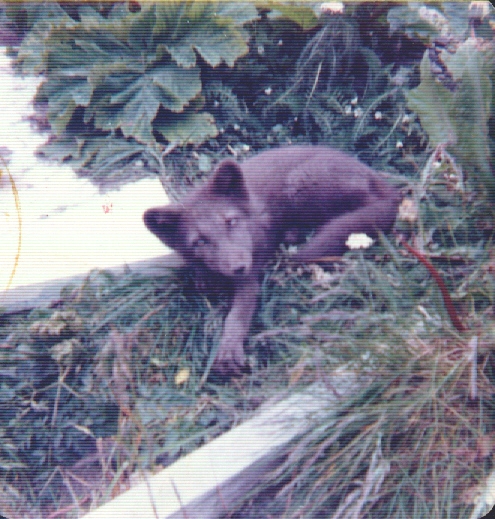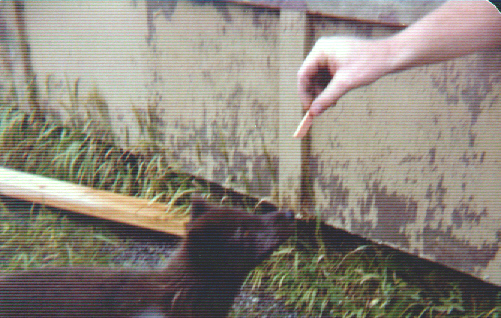

 |
 |
| Russian Blue Fox | Feeding Scruffy |
Discoveries in the 1740s by the intrepid Danish explorer and cartographer Vitus Bering, (after whom the Bering Straight is named), who worked for Russian Tsar Peter the Great and was also known as Ivan Ivanovich Bering, opened what is today's Aleutian Islands to several hundred years of bloody and vicious exploitation. The Unangan people (today called Aleuts); the fisheries; and the mammals, primarily the sea otter, mink, ermine, and foxes, were the focus of cruel and complete elimination. The political importance of Vitus Bering's discoveries and the frenzied harvests on and around Aleutian Islands are nearly forgotten today; but in the late 1700s, there was great competition for this area among the Russians, the British, the Spanish, and, eventually, the Americans. Each of these sea powers wanted not only the rich animal resources to satiate the unquenchable desires of the rich for fur clothing, but there were still hopes of finding shorter sea passage between the spice riches of the middle east and the voracious markets of Europe. Also, explorers of that era were governed by the rampant imperialistic philosophy of "If I can take and hold it first, it is mine."
Those who conducted the extensive and famous 1700s and 1800s fur harvests were called "promyshlenniki -- промышленники," free Siberian trappers and sailors who were ruthless but very efficeint. Before many decades had passed, the expertise of the promyshlenniki had reduced the sea otter (Enhydra lutris) and fox populations to near zero, similar to the early American exploitation successes against the beaver (Castor sp.) in what is today the western United States. In an attempt to keep up with fur pelt demand, the promyshlenniki attempted to raise and transplant sea otters and foxes. The sea otter proved impossible to breed in captivity, but the fox populations, especially the so-called Russian blue fox (Vulpes lagopus)-- which is actually dark brown or black and related to other Arctic foxes -- proved amenable to transplanting and raising in the wild. Consequently, in 1750, blue foxes were planted on Attu Island.
To be brief, soon all of the Akeutian Islands had Russian blue fox populations. After Russia sold Alaska to to the USA in 1867 for $7.2 million, American trappers continued to raise and harvest these transplanted blue foxes. Between 1890 and 1930, extensive fox farming was conducted by American fur entrepreneurs. Only after the market fell for fur clothing was it discovered that the transplanted foxes had decimated local island animal populations, particularly the Aleutian cackling goose (Branta hutchinsii leucopareia - formerly known as the Aleutian Canada goose) and other geese and duck species. Agreed, the trashing of the Aleutian Islands by WWII supply managers and their ubiquitous 55-gallon drums, ammo dumps, and quonset huts hadn't helped any of the indigenous animals either. So, now, you have had an abbreviated history refresher. Enter the US Fish and Wildlife Service (USFWS) and on to our real story.
USFWS was determined to clean up the Aleutian Islands. A primary focus was removal of WWII trash, wrecks, and eyesores. Another major effort was to eliminate the Russian blue foxes and restore habitat for Aleutian waterfowl. Those of you with early history on Rivet Amber, Rivet Ball, and Cobra Ball at Shemya would be surprised at how quickly the old WWII buildings (some of which we used as "clubhouses") were torn down and disposed of. Initially, it was a bit comical to see the building revetments surrounding misshapen pipes sticking out of the ground. Soon, even that disappeared.
Harry Swanson was raised at the foot of Mount Pilchuck in the Cascade Mountains of NW Washington state, 12 miles up the Mountain Loop Highway from Granite Falls. His father was a Mount Baker National Forest Ranger whose primary duties included management of the old-growth forest (which has long since been cut down) and burgeoning recreation. "Little" Harry, as he was then called (Lord, how the pounds of old age make a mockery out of that moniker!), spent all of his after-school time in the rainforest surrounding his remote home. Two of his favorite pastimes were building rafts to traverse the high mountain swamps and trapping of mink, foxes, and anything else unlucky enough to get caught.
Such activities not only made him small amounts of spending money, they formulated the outdoorsman philosophy that rules his thinking today. More to the point of our story, when he was stationed at the 6985th, he ran a trap line along the Tanana River and 23-mile Slough in his off-duty time. Such an endeavor provided him with lots of snow machining time for those days that the other Ripple Riders were flying or otherwise unavailable. Naturally, the new focus of the USFWS, ie. extermination of the Russian blue foxes at Shemya, fit right in with his psyche and duty schedule.
Butch Sadowski wanted to share in this potential fur bonanza, so Harry agreed to take him on as a trapper's apprentice. Harry showed Butch the ropes, teaching him about trap preparation; baiting and setting; use of scents; clean animal dispatch; and hide removal, processing, and sales. All of this took considerable time for a man of Butch's attention span, but that was OK because the permitting process from the USFWS took FOREVER, and getting reluctant permission from 6985th and Shemya commanders was slow to come, even after personal interviews with Swanson.
Soon, however, everything was in order. The weather had cooled and the foxes were in prime pelt. The TDY schedule arranged for both Swanson and Sadowski to be at Shemya at the same time. Supplies were loaded on the relief tanker and off to Shemya they went. On the way, Swanson urged Sadowski to keep what they were doing on the QT. Swanson's reasoning had to do with the up-tick in PETA protests against killing of any animals, particulary fur bearers, and the danger of spoiling set locations if curiosity seekers trampled the trap line.
After arrival, Swanson and Sadowski set six traps (they had agreed to start their get-rich scheme slowly) and baited them with chicken they had brought from Eielson. Just about any bait will do for foxes, but these blue foxes were accustomed to eating chow hall chicken and french fries given by well-meaning Air Force people stationed there. Next morning, our USAFSS promyshlenniki checked and found all traps sprung but no bait and no foxes.
Well, these must be smarter than the average foxes! They reset their half dozen traps that evening and checked again next morning. Same result: traps set off, no chicken bait present, and no foxes caught. How could this be? The blue foxes were everywhere and nearly tame. Swanson had counted 26 in one denning location on a previous scouting trip. Impossible! The same scenario greeted them for the next week, despite everything they did to counter this miserable failure.
Later, they learned that Sadowski couldn't help himself; he had spilled the beans about their plans. Their plans became known in the hangar and up at building 600 (who knew there was that much collaboration?). The foxes suddenly became everybody's pets. They were even given names, Scruffy 1, Scruffy 2, Yapper, and so on. Appointed crews of trap snappers were dispatched to save the Russian blue foxes from certain extinction. This endeavor was at an end.
In the early 2000s, the Aleutian cackling goose was removed from the endangered list. USFWS must have resorted to more conventional extermination efforts such as poison and high-priced contractors, professional trappers. It took 220 years for the Russian Blue fox to threaten the Canada Cackling Goose with extinction. Causing the extinction of the USAFSS promyshlenniki only took a week! Whenever Swanson hears the coyotes yapping near his Texas home, he think of this story and chuckles at the naivete of the USAFSS Promyshlenniki. RIP Sadowski.